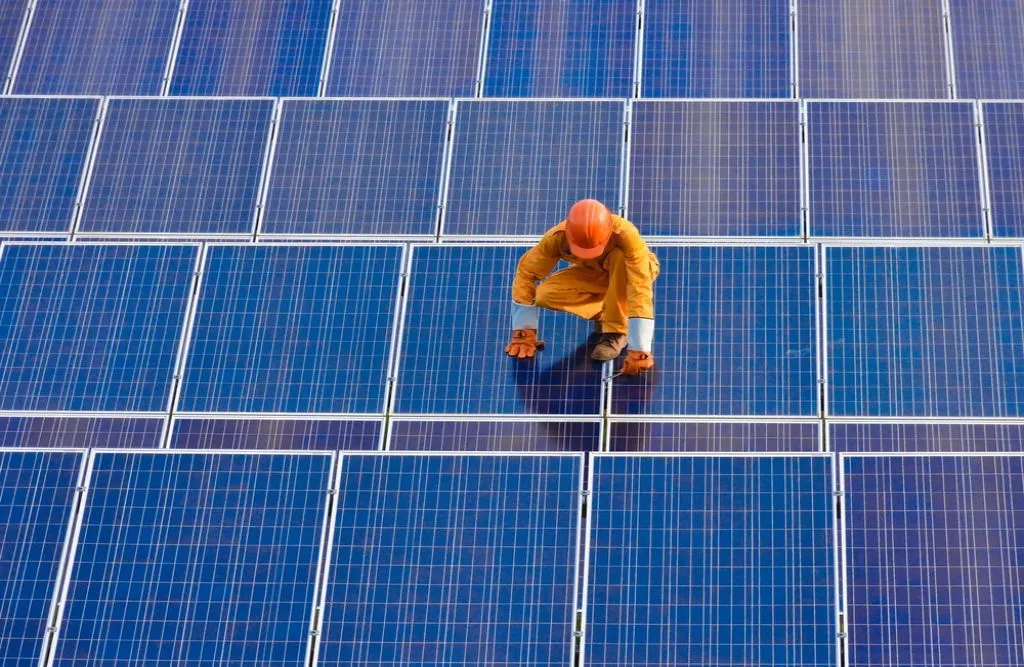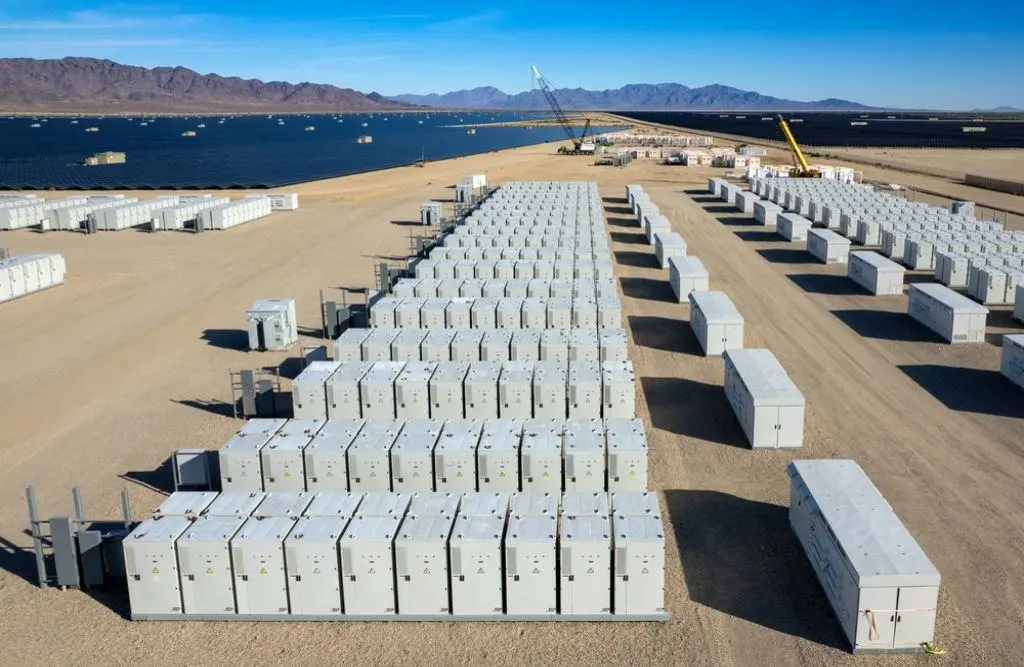Imagine powering your home with abundant energy while lowering or eliminating your grid reliance. You can already do it with solar energy solutions. However, can this energy keep your lights on 24/7? Yes, but you need ample storage. A tailored solar energy storage system can power your appliances even on long winter nights.
Today, you’ll learn how solar energy is stored, the main types of solar batteries, and which one best suits you. Whether you’re a homeowner curious about eco-friendly power or a businessman looking for clean commercial energy solutions, this article is for you! We’ll clear up any confusion and answer all your burning questions.
How Does Solar Energy Work: A Quick Recap
Solar panels harness the sun’s rays and turn them into usable electricity through the photovoltaic effect. Each sun ray contains thousands of photons. When those particles hit a silicon atom inside the solar power cell, they inject energy. This energy bump excites an electron in the atom, breaking it free from its orbit and setting it in motion.
The freed electron, eager to find a new home, is guided by the clever design of the PV cell. An internal electric field acts as a gentle push, directing the electron toward the positive side of the cell.
As more sunlight hits the panel, more electrons are set in motion, forced to flow in the same direction by the electric field. This movement of electrons generates a Direct Current (DC), a versatile form of energy that can power various devices, from cars with Level 3 chargers to less powerful devices that require Alternating Current (AC).
While solar panels themselves don’t store energy, they can team up with batteries to create a solar energy storage system. These batteries capture excess DC electricity produced during sunny periods and store it for later use, like at night or on cloudy days when sunlight is limited. This way, you can maximize the use of your solar-generated power.
What Happens To Generated Electricity: On-Grid, Off-Grid, and a Hybrid Solar Energy Storage System

In the perfect scenario, the electricity generated by the panel perfectly meets your current needs, so it just flows from the panels to the inverter and onward to your appliances.
However, we don’t live in a perfect world. Even in summer, there are still at least 7-9 hours without a Sun. That’s why solar panel owners still need to think about how to store solar power or get discounts on grid electricity.
- If your local provider offers net metering, you can send excess power to receive metering credits, which can be applied to lower your power bills later. If net metering isn’t supported or if you prefer to go completely off-grid, we suggest having your own solar electricity storage.
You can use a solar energy storage system on cloudy days or at night to power your appliances. It acts as a big power bank, collecting excessive electricity. However, you will need the inverter to convert DC electricity to the AC for your appliance.
Additionally, you can benefit from using hybrid solar power storage. These systems combine elements of both on-grid and off-grid systems, offering more flexibility and resilience than either one alone. They have a highly customizable inverter, which you can program according to your preference:
- Sending energy to the grid
- Using batteries
- Drawing from the grid
By default, hybrid solar storage solutions prioritize self-consumption by using solar power to fill batteries and only send excesses to the grid. However, you can change those settings to suit your habits.
How Solar Panels Store Energy: The Processes Behind The Scene
Batteries don’t directly store electricity. They use chemical reactions to reserve energy in their solar energy storage. In most systems, a separate inverter transforms DC from solar panels to AC to power your home appliances. Some systems have an inverter integrated into batteries.
Most batteries also have a charge controller that regulates the incoming current to prevent overcharging. In the long run, overcharging can damage the batteries and shorten their lifespan. That’s why you should look for more resistant options for storing solar energy. It may seem more costly at first, but eventually, it can save you thousands of dollars by increasing the batteries’ lifespan.
Once regulated, the electricity flows into the solar energy storage, a.k.a solar battery. It creates chemical reactions between electrolytes (for lead batteries) or ions (for lithium batteries) and electrodes. Inside each battery, chemical reactions occur between the electrodes (positive and negative) and the electrolyte or ion. The specific chemical reactions in a solar energy storage system depend on the battery type.
Imagine the battery as a container and the chemical reactions as a process that changes a liquid inside the container (electrolyte or ion) into a different form. This new form holds the energy from solar energy storage. Discharging reverses the process, converting the liquid back to its original form and releasing the stored energy.
These chemical reactions store the electrical energy from the DC. There are no solar panels that store energy since they don’t have a place to store the electrodes and electrolytes in the long run. You need batteries to reserve excessive power.
2 Main Types of Batteries to Store Solar Power

Solar systems primarily use two types of batteries to store energy: lithium-ion (Li-ion) and lead-acid batteries. Each solar energy storage system has its advantages and disadvantages, for instance:
- Lead-acid options have lower upfront costs but last 5-7 years less than Li-ion batteries.
- Lead-acid storage requires periodic maintenance, such as checking electrolyte levels, while lithium-ion batteries are carefree. They only need regular dust cleaning.
Li-Ion Solar Batteries
It’s a lightweight and efficient option for those who want to store energy collected by solar cells.
- Li-ion batteries offer high round-trip efficiency, meaning they lose less power during charging and discharging compared to lead-acid batteries. Li-ion batteries typically have a 10-15-year performance warranty.
Unlike lead-acid batteries, which rely on lead plates submerged in acid, lithium-ion solar energy storage systems use lithium ions to move between electrodes. The cathode (positive electrode) and anode (negative electrode) are made from specific materials that allow lithium ions to shuttle back and forth during charging and discharging.
They also require minimal maintenance compared to lead-acid batteries, which need occasional watering. With Li-ion solar energy storage options, you don’t need to worry about electrolyte levels or topping them up with water (except for some advanced flooded Li-ion systems).
However, a Li-ion solar energy storage system costs more than lead-acid options. Li-ion batteries are also susceptible to temperature. They perform best in moderate temperatures, but extreme heat or cold can reduce their efficiency and lifespan.
Lead Acid
These batteries are a more affordable option. Lead-acid energy storage has been around for over 160 years. They rely on a well-understood chemical reaction between lead plates (electrodes) submerged in a sulfuric acid electrolyte solution.
During charging, an external source (like your solar panels) pushes electrons through the circuit, converting lead sulfate on the plates back to lead (anode) and lead dioxide (cathode). When discharging, the electrons flow in the opposite direction of the solar energy storage system, reversing the chemical reaction and generating electricity.
However, these solar energy storage solutions are losing their efficiency faster than Li-ion batteries. That’s why most lead-acid solar batteries have only a 5-7 year warranty. After that period, their efficiency may drop to 50%. Thus, they have become less and less popular methods of storing energy from solar panels.
They also require regular care, such as checking and refilling water levels (flooded lead-acid) to prevent damage. You should also remember that lead is a toxic metal, so it will be harder to utilize those batteries once they die.
Harnessing the Sun’s Power With Solar Energy Storage Systems
Solar panels are a fantastic way to tap into clean, renewable energy from the sun. While they can’t store energy directly, battery storage systems provide a solution. They use clever chemistry to hold onto the electricity generated by your panels, allowing you to utilize it even at night.
You can maximize the amount of usable electricity by strategically placing your panels and incorporating solar energy storage advancements like microinverters and batteries.
Whether your goal is self-reliance, backup power during outages, or reducing your dependence on the grid, understanding how a solar energy storage system works can empower you to make even more informed decisions for your home or business.
Consulting with a qualified solar professional can help you design a system that allows you to harness the sun’s energy and enjoy the benefits of clean, renewable power. We at Solar Power Systems can help you find a local installer team that incorporates the best decisions for your needs.
Frequently Asked Questions
How is solar energy collected by panels?
Panels capture the sun’s energy through a process called the photovoltaic effect. Each sunbeam contains thousands of photons. When a photon hits a silicon atom in the PV cell, it injects its energy, breaking an electron free and setting it in motion. The solar cell is designed with an internal electric field that directs the loose electron toward the positive side of the cell, creating an electric current known as Direct Current (DC).
How to store electricity from solar panels
Solar panels themselves cannot directly store electricity. They convert sunlight into usable DC electricity, but you need a battery storage system to save this energy. In some systems, especially with microinverters mounted on each panel, the DC electricity might directly go to battery storage. You must use a separate one if your batteries don’t have a built-in inverter.
How to collect solar energy most efficiently
To optimize sunlight exposure, locate panels in areas with unobstructed sunlight throughout the day. Slightly tilt panels to ensure that the tilting angle is close to the location’s latitude. Regularly clean them from dust, dirt, and bird droppings.
Can solar panels store energy on their own?
No, they can’t do it. Panels are excellent at converting sunlight into electricity, but they lack the internal mechanisms to hold that electrical energy for later use. You need solar energy storage systems (batteries and an inverter) to store the electricity and convert it to AC for your appliances.


